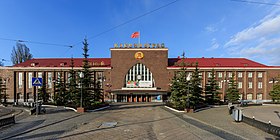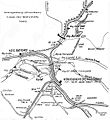Kaliningrad-Passashirski railway station
| Kaliningrad-Passashirski Калининград-Пассажирский |
|
|---|---|
|
The station opened in 1929
|
|
| Data | |
| Location in the network | Separation station |
| Design | Through station |
| Platform tracks | 10 |
| IBNR | 2000047 |
| opening | September 19, 1929 |
| Architectural data | |
| Architectural style | Expressionism / brick Gothic |
| location | |
| City / municipality | Kaliningrad |
| Oblast | Kaliningrad |
| Country | Russia |
| Coordinates | 54 ° 41 '40 " N , 20 ° 29' 54" E |
| List of train stations in Russia | |
The Kaliningrad-Passaschirski station ( Russian Калининград-Пассажирский ) is the most important passenger station in the Russian city of Kaliningrad (formerly Königsberg i.Pr. ). It bears this name in long-distance transport. The term Kaliningrad Juschny (Калининград-Южный, Kaliningrad South) is used for regional transport. The name Juschny Woksal (Südbahnhof) is also in large letters above the central part of the reception building.
history
After 17 years of construction, which was interrupted by the First World War , the station was opened on September 19, 1929 as Königsberg (Pr) Hauptbahnhof in place of the previous Königsberg Süd and Königsberg Ost stations, southwest of the former city center in the area of the former city fortifications. At that time it was one of the most modern railway stations of the Deutsche Reichsbahn, had a three-aisled hall, a spacious reception building in architectural style based on Expressionism or brick Gothic, separate baggage tunnels and restaurants . A four-track turning loop of the Königsberg tram was laid on the forecourt. From the beginning to the end of the Second World War , Königsberg Central Station was an international and national traffic hub on the Prussian Eastern Railway with important trains such as the D 1 Berlin – Königsberg – Eydtkuhnen – Riga and through coaches to Liebau , Warsaw , Breslau , Dresden and Paris . After the German city of Königsberg, like the entire northern part of the German province of East Prussia, fell to the Soviet Union in 1945, this changed abruptly when the city, renamed Kaliningrad in 1946, became a Soviet military restricted area. The tracks of the largely intact remaining station were around 1950 on Russian broad gauge umgespurt . The station could no longer be reached on the regular lane. Due to the relocation of the city center to the north-west in the area of the north station , the station was renamed Südbahnhof (or in the timetable usage for long-distance traffic "Passenger Station " - Passaschirski ) and was henceforth the end point of trains from Moscow , Saint Petersburg , Homel , Kharkov and Anapa . Two platform tracks were electrified. Since then, several suburban trains ( Elektritschka ) have been running from here via a single-track connection to the North Railway Station in Kaliningrad Severny and from there to the Samland seaside resorts. The first train from Poland and Germany reached Kaliningrad on August 9, 1991 as a special tourist train from Berlin . This was possible because for military reasons there was a continuous standard gauge track from the Braniewo (Braunsberg) - Mamonowo (Heiligenbeil) border crossing to the Kaliningrad freight station in the south of the city (so-called "international track"). In 1993, this standard gauge connection was extended to the south station using a previously vacant track trough in the platform hall, so that trains from Central Europe can run there.
Current condition
For the 750th anniversary of the city in 2005, the station was completely renovated. The glass roof, which had only been sparsely repaired with wooden boards after the Second World War, was completely renewed and the vestibule was equipped with a new granite floor, chandeliers and fountain. From 2008, historicized cast iron lanterns were set up inside the platform hall to further improve the lighting conditions. The platforms were raised by 40 centimeters and tiled to enable more convenient entry and exit.
Until 2012, trains to Gdynia in Poland ran once a day from the international track with through coaches to Berlin. Corridor traffic to the Russian heartland is of far greater importance . There are currently (as of October 2015) express trains daily to Moscow , three times a week to Saint Petersburg and twice a week to Adler (Sochi) .
photos
literature
- Judge: The new railway systems in Königsberg (Pr.) E. The buildings . In: Zeitschrift für Bauwesen , vol. 80, 1930, pp. 311-320 ( digitized version of the Central and State Library Berlin ).
- Robert Albinus: Königsberg Lexicon. City and surroundings . Flechsig, Würzburg 2002, ISBN 3-88189-441-1 .
- Richard Armstedt: history of the royal. Capital and residence city of Königsberg in Prussia. Hobbing & Büchle, Stuttgart 1899 ( German land and life in single descriptions . 2, city stories), (reprint: Melchior-Verlag, Wolfenbüttel 2006, ISBN 3-939102-70-9 ( historical library )).
- Fritz Gause : The history of the city of Königsberg in Prussia. 3 volumes. 2nd / 3rd supplemented edition. Böhlau, Cologne et al. 1996, ISBN 3-412-08896-X .
- Henrik Karl Nielsen: Kaliningrad (Königsberg Pr.). Cityscape, city traffic and tram . Europublishers, Copenhagen 2008, ISBN 978-87-90528-21-8 .
- Jürgen Manthey : Königsberg - history of a world citizenship republic . Hanser , Munich 2005, ISBN 3-446-20619-1 .
- Gunnar Strunz: Discover Königsberg. Between Memel and fresh lagoon . Trescher, Berlin 2006, ISBN 3-89794-071-X .
- Gerhard Greß / Jörg Petzold: East Prussia and its traffic routes , part 1 and 2, VGB Verlagsgruppe Bahn 2019, ISBN 978-3-8375-2075-0
Individual evidence
- ↑ Cf. Geißler, Andreas / Koschinski, Konrad (1997): 130 years of the Ostbahn. Berlin - Königsberg - Baltic States, Berlin: GVE, p. 112
- ↑ Issue 11/2009 of the Königsberger Express
- ↑ Departures Kaliningrad-Juzhny (Russian)











